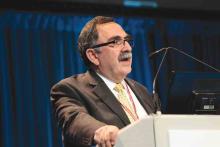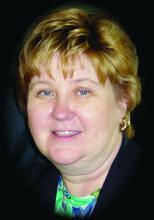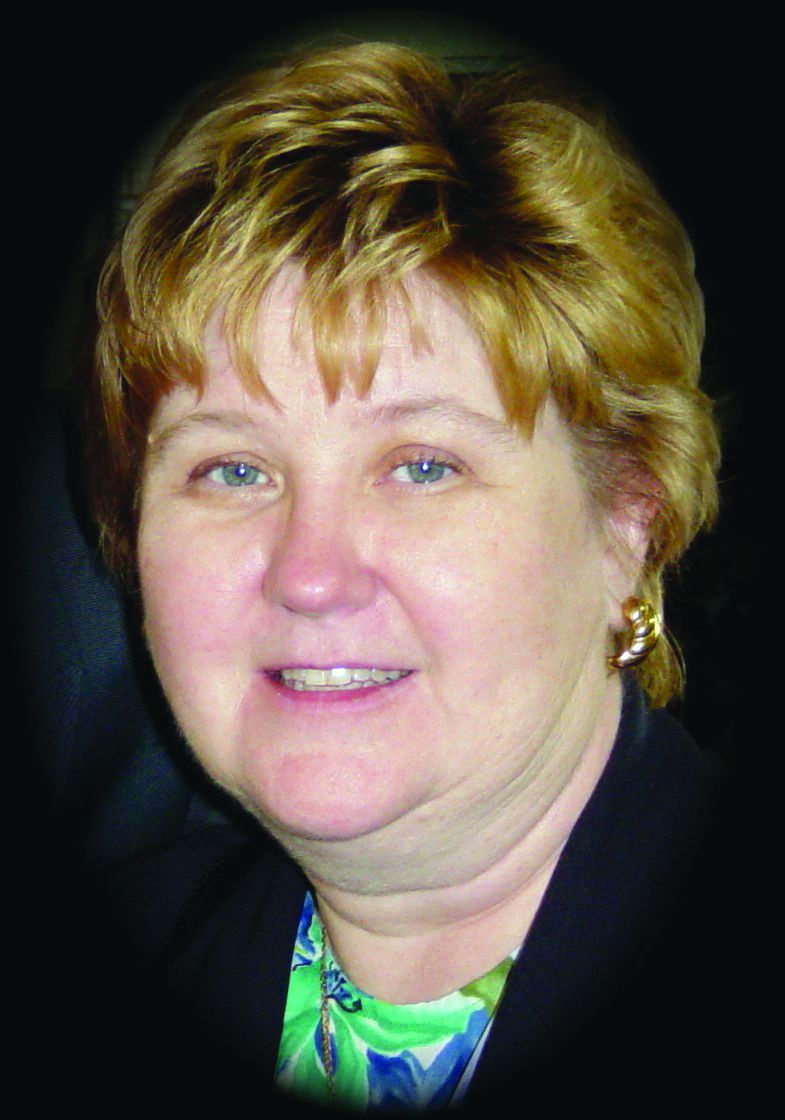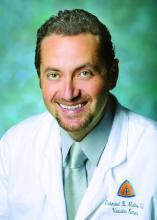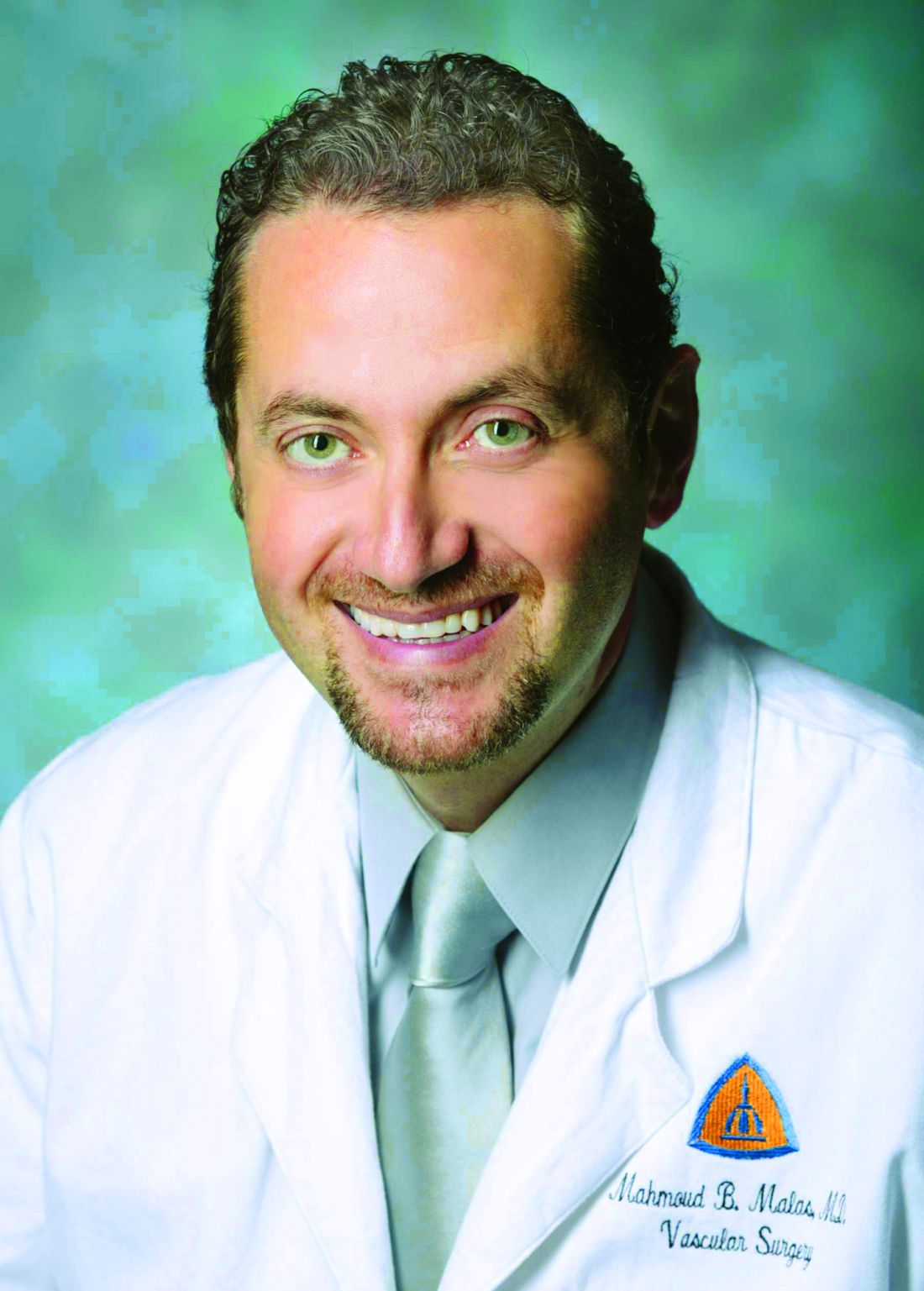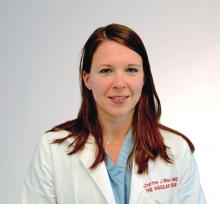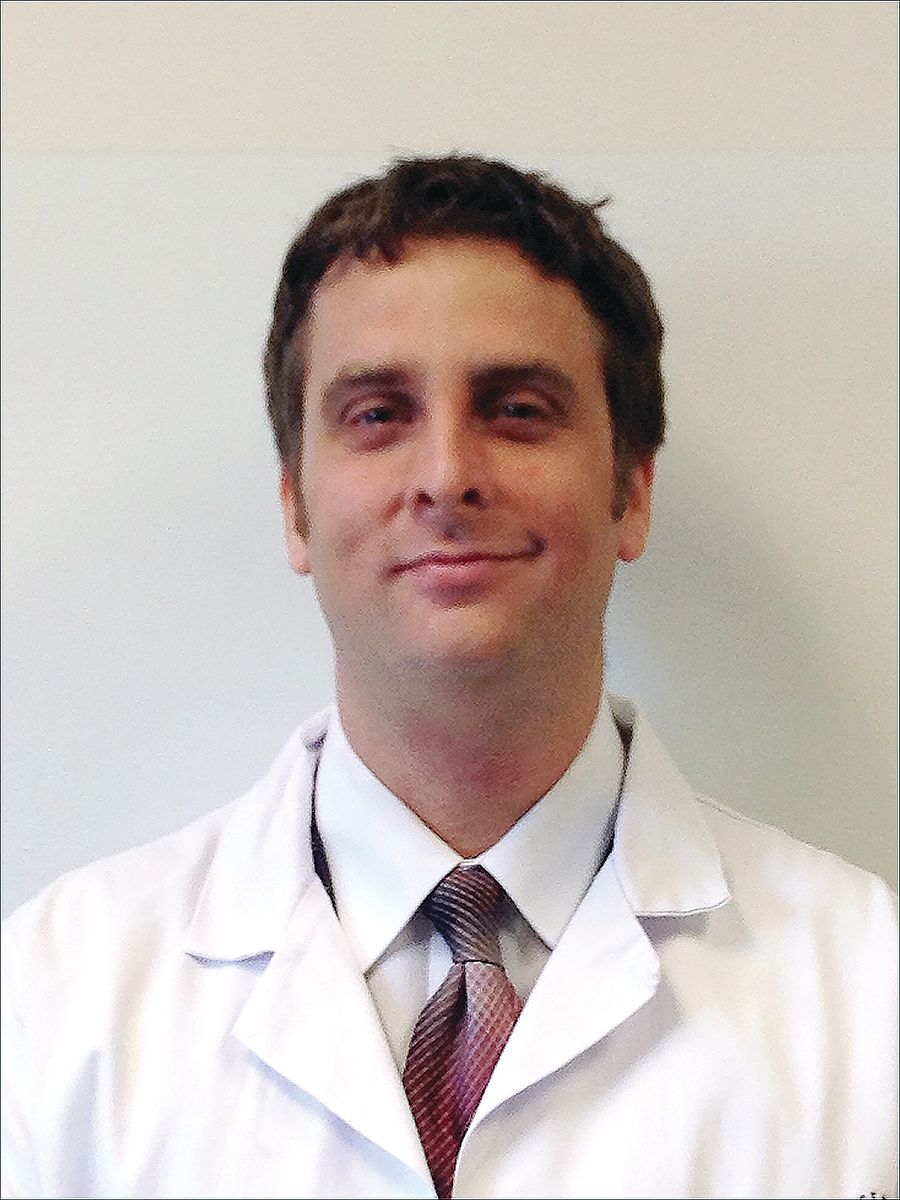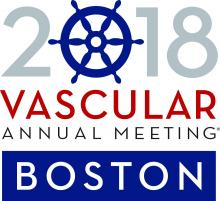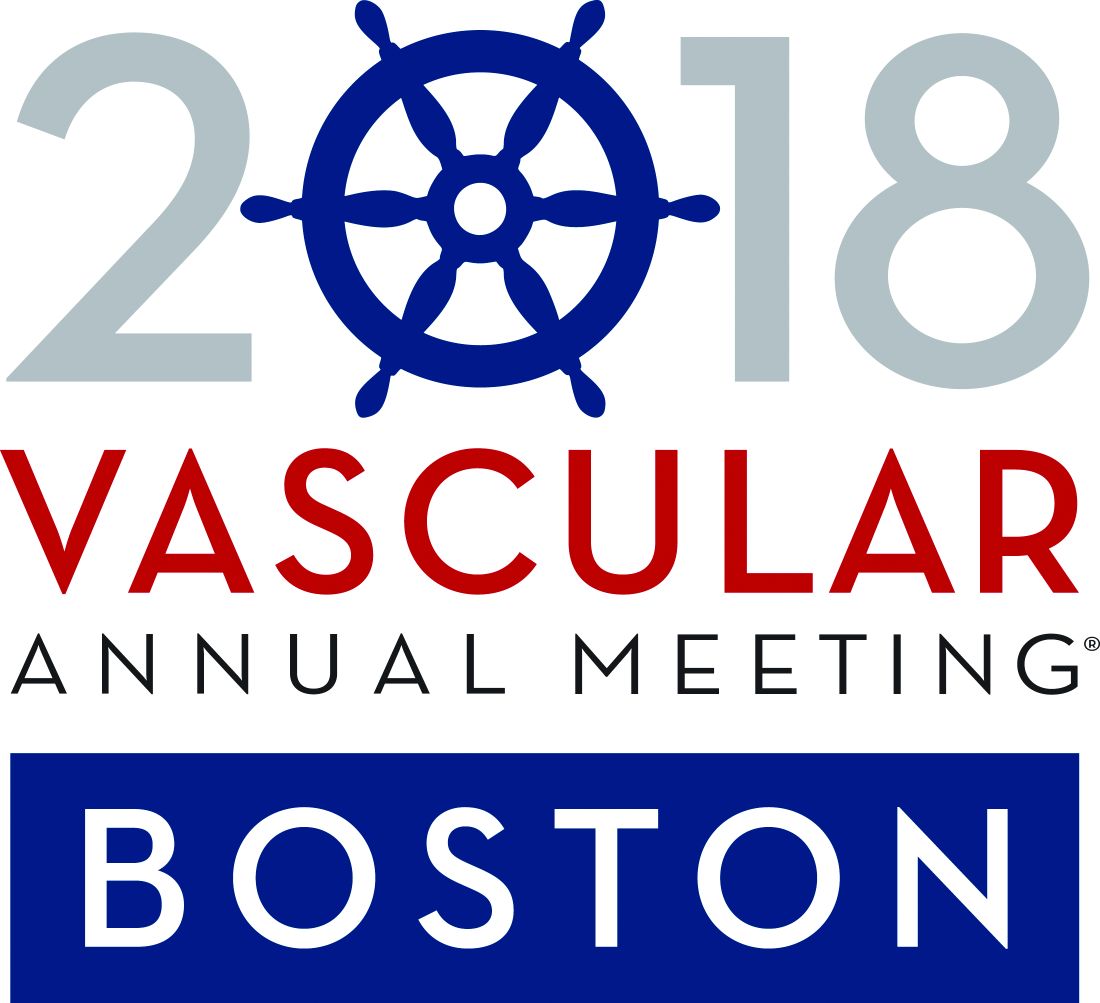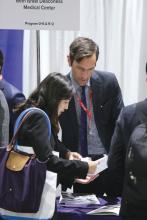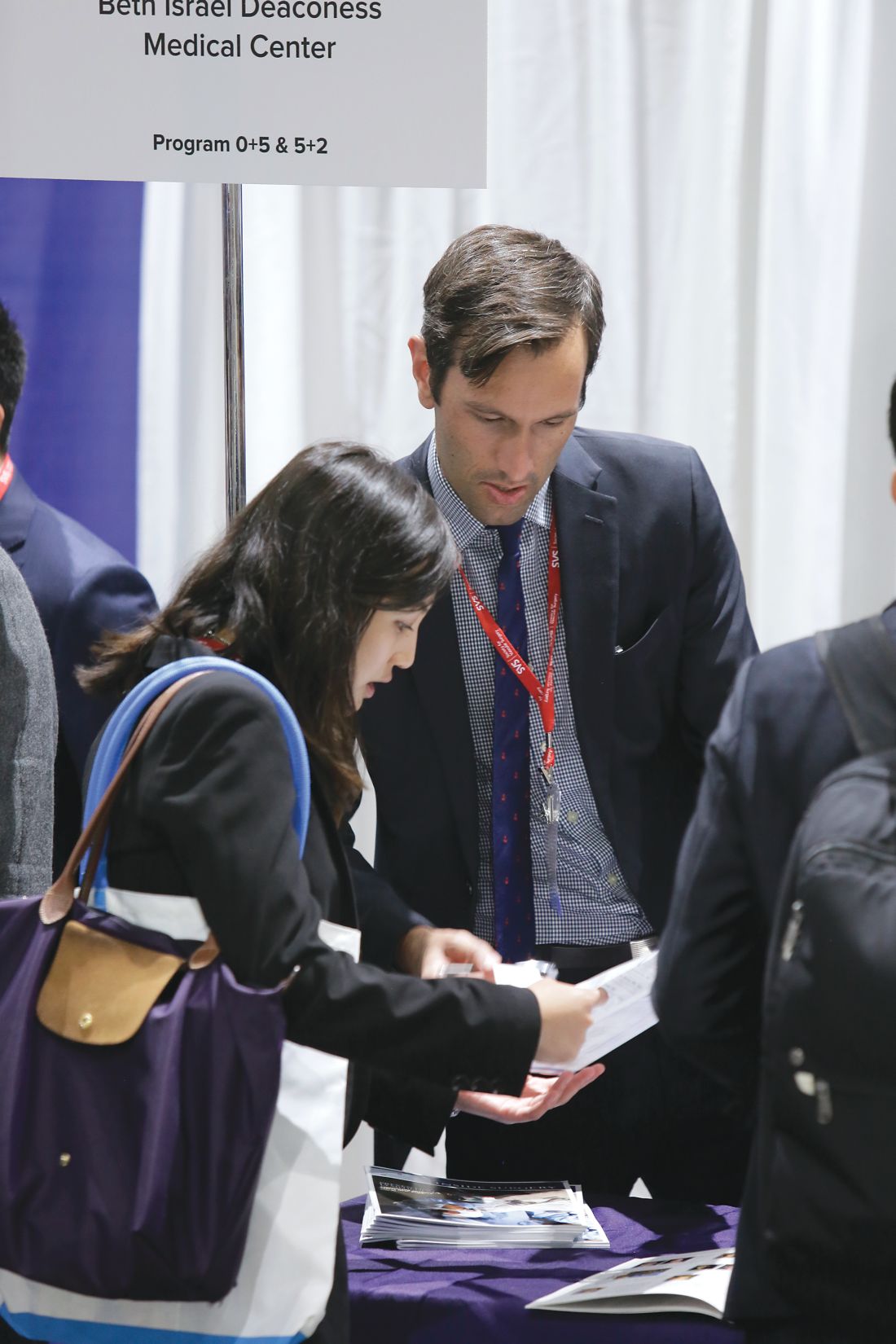User login
Crawford Critical Issues Forum Covers the National Shortage of Vascular Surgeons
This year’s E. Stanley Crawford Critical Issues Forum addressed the current status of the vascular surgery workforce, its existing geographic distribution, the potential for a worsening shortage, and proposed solutions to ensure future vascular care delivery.
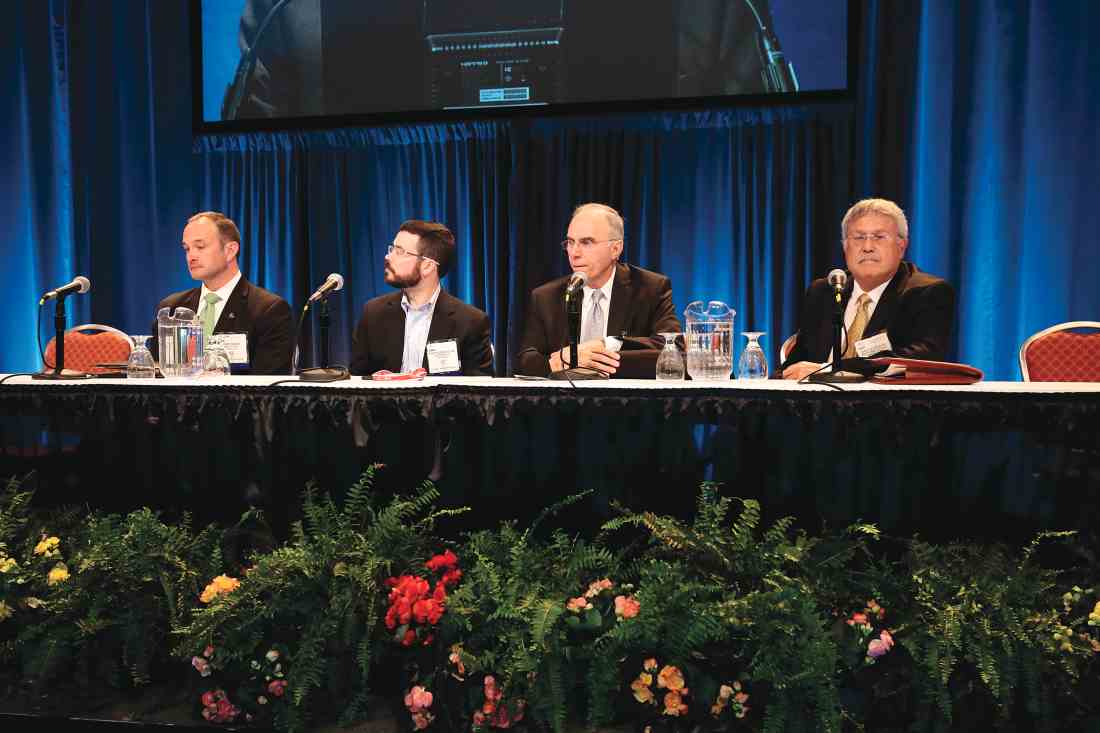
As is tradition, the forum was organized and moderated by the SVS president-elect, this year Michel S. Makaroun, MD, co-director of the UPMC Heart and Vascular Institute in Pittsburgh. The session began with an overview from Dr. Makaroun on the critical nature of the growing problem.
He described how the current shortage of vascular surgeons is projected to worsen for two main reasons: First, newly trained vascular surgeons are not entering the workforce in adequate numbers to meet the increased demand presented by the nation’s aging population, even with the improvements projected from the new 0-5 training program; second, there is a large percentage of vascular surgeons currently practicing who are expected to retire in the next decade, with estimates reaching 35%-45%. He detailed the results of the 2017 survey of vascular surgeons that showed this and other concerning factors.
“We do not take vacations,” he said. “We have significant overwork.” In addition, “half of the surgeons who said they would retire, said they would retire before the age of 65.” In fact, nearly 50% of those surveyed have firm retirement plans, and nearly 20% were planning on retiring within the next five years.
“To summarize, we have a pipeline, which at maximum would within the next five years introduce 608 new vascular resident and fellow graduates into the workforce, and at the same time we’ll be losing the same number of practicing vascular surgeons. So, at best, we will stay even,” said Dr. Makaroun.
“The Current Landscape of the Vascular Surgery Recruitment Market” was addressed by Jeremy Robinson of Merritt Hawkins. He pointed out the market evidence for a large scarcity of vascular surgeons, with a huge number of positions going unfilled, more than half of new trainees receiving more than 100 offers, and bidding wars going on among employers, including offering expansive salaries and benefits to vascular surgeons as part of recruitment efforts.
In his talk, “Where Did the Vascular Surgeons Go? Seven Years of Futile Recruitment Attempts,” Gerald Goldstein, MD, of the Western Maryland Health System, addressed the problem of attracting new vascular surgeons. His talk was key in pointing out the problems of large health care facilities in poor and rural areas. “We’re not a Band-Aid station. ... we’re a big hospital, we serve a large geographic area and a large cohort of patients,” he said. Still they have failed to recruit a single vascular surgeon. He pointed out how places such as his could not compete for vascular surgeons against more desirable urban centers with more amenities and sufficient backup surgeons to provide lower workloads and improved quality of life, which includes time off, not being on call, and collaboration and teamwork. He was not optimistic about solutions and was fighting the final solution: hospital contraction of services.
“Workforce Targets: How Can We Know Whether We Have Enough Vascular Surgeons?” was discussed by Mark Friedberg, MD, of the RAND Corporation. Dr. Friedberg pointed out that it was important to define what was meant by a shortage of vascular surgeons, asking whether a surgeon/population metric was the most valuable or should it include other components, such as geographic considerations, quality of care issues, patient waiting times, and more. In addition, he asked, for any metric chosen, how was the decision made in choosing the optimal level? What is the best ratio of vascular surgeons to population, and how do you decide it?
Finally, Anton Sidawy, MD, of the George Washington University Hospital, Washington, looked at possible solutions to the problem in his talk, “Pathways to Alleviate Shortages and Maldistributions of Vascular Surgeons.” Dr. Sidawy stressed the need for a multifaceted approach, including government at the federal, state, and local levels, as well as medical schools and training programs. He particularly stressed the need for improving the distribution of vascular surgeons to underserved rural areas, such as described by Dr. Goldstein. However, this would require thinking outside the box, perhaps involving redistribution of training to more underserved areas of the country and also recruitment of more individuals from those areas. This is more likely to produce vascular surgeons willing to remain or return to such areas to practice, as has been well documented.
Another possibility is to provide incentives for older vascular surgeons to delay retirement, perhaps with lowered workload, freedom from being on-call, and other benefits.
But perhaps his most radical suggestion is the idea of rethinking the role of vascular surgeons entirely, to include the ability to perform more general surgery operations, allowing them more flexibility to take on roles in smaller communities and organizations that could not afford a narrowly defined specialist.
The forum concluded with a panel discussion in which the panelists addressed questions from the audience.
This year’s E. Stanley Crawford Critical Issues Forum addressed the current status of the vascular surgery workforce, its existing geographic distribution, the potential for a worsening shortage, and proposed solutions to ensure future vascular care delivery.

As is tradition, the forum was organized and moderated by the SVS president-elect, this year Michel S. Makaroun, MD, co-director of the UPMC Heart and Vascular Institute in Pittsburgh. The session began with an overview from Dr. Makaroun on the critical nature of the growing problem.
He described how the current shortage of vascular surgeons is projected to worsen for two main reasons: First, newly trained vascular surgeons are not entering the workforce in adequate numbers to meet the increased demand presented by the nation’s aging population, even with the improvements projected from the new 0-5 training program; second, there is a large percentage of vascular surgeons currently practicing who are expected to retire in the next decade, with estimates reaching 35%-45%. He detailed the results of the 2017 survey of vascular surgeons that showed this and other concerning factors.
“We do not take vacations,” he said. “We have significant overwork.” In addition, “half of the surgeons who said they would retire, said they would retire before the age of 65.” In fact, nearly 50% of those surveyed have firm retirement plans, and nearly 20% were planning on retiring within the next five years.
“To summarize, we have a pipeline, which at maximum would within the next five years introduce 608 new vascular resident and fellow graduates into the workforce, and at the same time we’ll be losing the same number of practicing vascular surgeons. So, at best, we will stay even,” said Dr. Makaroun.
“The Current Landscape of the Vascular Surgery Recruitment Market” was addressed by Jeremy Robinson of Merritt Hawkins. He pointed out the market evidence for a large scarcity of vascular surgeons, with a huge number of positions going unfilled, more than half of new trainees receiving more than 100 offers, and bidding wars going on among employers, including offering expansive salaries and benefits to vascular surgeons as part of recruitment efforts.
In his talk, “Where Did the Vascular Surgeons Go? Seven Years of Futile Recruitment Attempts,” Gerald Goldstein, MD, of the Western Maryland Health System, addressed the problem of attracting new vascular surgeons. His talk was key in pointing out the problems of large health care facilities in poor and rural areas. “We’re not a Band-Aid station. ... we’re a big hospital, we serve a large geographic area and a large cohort of patients,” he said. Still they have failed to recruit a single vascular surgeon. He pointed out how places such as his could not compete for vascular surgeons against more desirable urban centers with more amenities and sufficient backup surgeons to provide lower workloads and improved quality of life, which includes time off, not being on call, and collaboration and teamwork. He was not optimistic about solutions and was fighting the final solution: hospital contraction of services.
“Workforce Targets: How Can We Know Whether We Have Enough Vascular Surgeons?” was discussed by Mark Friedberg, MD, of the RAND Corporation. Dr. Friedberg pointed out that it was important to define what was meant by a shortage of vascular surgeons, asking whether a surgeon/population metric was the most valuable or should it include other components, such as geographic considerations, quality of care issues, patient waiting times, and more. In addition, he asked, for any metric chosen, how was the decision made in choosing the optimal level? What is the best ratio of vascular surgeons to population, and how do you decide it?
Finally, Anton Sidawy, MD, of the George Washington University Hospital, Washington, looked at possible solutions to the problem in his talk, “Pathways to Alleviate Shortages and Maldistributions of Vascular Surgeons.” Dr. Sidawy stressed the need for a multifaceted approach, including government at the federal, state, and local levels, as well as medical schools and training programs. He particularly stressed the need for improving the distribution of vascular surgeons to underserved rural areas, such as described by Dr. Goldstein. However, this would require thinking outside the box, perhaps involving redistribution of training to more underserved areas of the country and also recruitment of more individuals from those areas. This is more likely to produce vascular surgeons willing to remain or return to such areas to practice, as has been well documented.
Another possibility is to provide incentives for older vascular surgeons to delay retirement, perhaps with lowered workload, freedom from being on-call, and other benefits.
But perhaps his most radical suggestion is the idea of rethinking the role of vascular surgeons entirely, to include the ability to perform more general surgery operations, allowing them more flexibility to take on roles in smaller communities and organizations that could not afford a narrowly defined specialist.
The forum concluded with a panel discussion in which the panelists addressed questions from the audience.
This year’s E. Stanley Crawford Critical Issues Forum addressed the current status of the vascular surgery workforce, its existing geographic distribution, the potential for a worsening shortage, and proposed solutions to ensure future vascular care delivery.

As is tradition, the forum was organized and moderated by the SVS president-elect, this year Michel S. Makaroun, MD, co-director of the UPMC Heart and Vascular Institute in Pittsburgh. The session began with an overview from Dr. Makaroun on the critical nature of the growing problem.
He described how the current shortage of vascular surgeons is projected to worsen for two main reasons: First, newly trained vascular surgeons are not entering the workforce in adequate numbers to meet the increased demand presented by the nation’s aging population, even with the improvements projected from the new 0-5 training program; second, there is a large percentage of vascular surgeons currently practicing who are expected to retire in the next decade, with estimates reaching 35%-45%. He detailed the results of the 2017 survey of vascular surgeons that showed this and other concerning factors.
“We do not take vacations,” he said. “We have significant overwork.” In addition, “half of the surgeons who said they would retire, said they would retire before the age of 65.” In fact, nearly 50% of those surveyed have firm retirement plans, and nearly 20% were planning on retiring within the next five years.
“To summarize, we have a pipeline, which at maximum would within the next five years introduce 608 new vascular resident and fellow graduates into the workforce, and at the same time we’ll be losing the same number of practicing vascular surgeons. So, at best, we will stay even,” said Dr. Makaroun.
“The Current Landscape of the Vascular Surgery Recruitment Market” was addressed by Jeremy Robinson of Merritt Hawkins. He pointed out the market evidence for a large scarcity of vascular surgeons, with a huge number of positions going unfilled, more than half of new trainees receiving more than 100 offers, and bidding wars going on among employers, including offering expansive salaries and benefits to vascular surgeons as part of recruitment efforts.
In his talk, “Where Did the Vascular Surgeons Go? Seven Years of Futile Recruitment Attempts,” Gerald Goldstein, MD, of the Western Maryland Health System, addressed the problem of attracting new vascular surgeons. His talk was key in pointing out the problems of large health care facilities in poor and rural areas. “We’re not a Band-Aid station. ... we’re a big hospital, we serve a large geographic area and a large cohort of patients,” he said. Still they have failed to recruit a single vascular surgeon. He pointed out how places such as his could not compete for vascular surgeons against more desirable urban centers with more amenities and sufficient backup surgeons to provide lower workloads and improved quality of life, which includes time off, not being on call, and collaboration and teamwork. He was not optimistic about solutions and was fighting the final solution: hospital contraction of services.
“Workforce Targets: How Can We Know Whether We Have Enough Vascular Surgeons?” was discussed by Mark Friedberg, MD, of the RAND Corporation. Dr. Friedberg pointed out that it was important to define what was meant by a shortage of vascular surgeons, asking whether a surgeon/population metric was the most valuable or should it include other components, such as geographic considerations, quality of care issues, patient waiting times, and more. In addition, he asked, for any metric chosen, how was the decision made in choosing the optimal level? What is the best ratio of vascular surgeons to population, and how do you decide it?
Finally, Anton Sidawy, MD, of the George Washington University Hospital, Washington, looked at possible solutions to the problem in his talk, “Pathways to Alleviate Shortages and Maldistributions of Vascular Surgeons.” Dr. Sidawy stressed the need for a multifaceted approach, including government at the federal, state, and local levels, as well as medical schools and training programs. He particularly stressed the need for improving the distribution of vascular surgeons to underserved rural areas, such as described by Dr. Goldstein. However, this would require thinking outside the box, perhaps involving redistribution of training to more underserved areas of the country and also recruitment of more individuals from those areas. This is more likely to produce vascular surgeons willing to remain or return to such areas to practice, as has been well documented.
Another possibility is to provide incentives for older vascular surgeons to delay retirement, perhaps with lowered workload, freedom from being on-call, and other benefits.
But perhaps his most radical suggestion is the idea of rethinking the role of vascular surgeons entirely, to include the ability to perform more general surgery operations, allowing them more flexibility to take on roles in smaller communities and organizations that could not afford a narrowly defined specialist.
The forum concluded with a panel discussion in which the panelists addressed questions from the audience.
Preop Cognitive Issues and Surgery Type Affect Postop Delirium
Postoperative delirium has a high prevalence among vascular surgery patients, increasing morbidity, mortality and length of stay (LOS),according to Rima G. Styra, MD, and her colleagues at the University of Toronto (Canada).
In Friday’s Scientific Session 5, Dr. Styra will present their prospective study, which found that there were preop risk factors for delirium that can be determined by a surgical team in order to identify high risk patients; their study also looked at the impacts of delirium on hospital costs.
She and her colleagues preoperatively assessed 173 elective vascular surgery patients for cognitive function using the Montreal Cognitive Assessment Scale (MoCA) and the Confusion Assessment Method (CAM) for postoperative delirium, which was verified by chart and clinical review.
Demographic information, medications and a history of substance abuse, psychiatric disorders, previous delirium and the surgical procedure were prospectively recorded. An accompanying retrospective chart review of an additional 434 (elective and emergency) vascular surgery patients provided supplemental cost information related to sitter use and prolonged hospitalization secondary to three factors: delirium alone, dementia alone, and delirium and dementia.
Prospective screening of 173 patients (73.4% men, mean age 69.9 years), identified that 119 (68.8%) had MoCA scores indicating cognitive impairment, with 7.5% having severe impairment (dementia). Patients who underwent amputation had significantly lower MoCA scores (15.9 out of 30) compared to open and endovascular aortic surgery patients (23.6 out of 30). The normal range for MoCA is 25-30.
The incidence of delirium was 12% in the elective cohort. Regression analysis identified significant predictors of delirium including type of surgery: lower limb amputation (OR 16.7), open aortic repair (OR 5.3), and cognitive variables: dementia (OR 5.6), and MoCA scores indicating moderate to severe impairment (OR 5.6), and previous delirium (OR 3.0).
Retrospective review of 434 patients identified differences between sitter needs for patients with delirium and dementia (mean = 13.6 days), delirium alone (3.9 days) or dementia alone (less than 1day [17.7 hours]). A total of 15 patients required more than 200 hours (8.3 days), accounting for 69.7% of sitter costs for the surgical unit. Patients with underlying dementia who developed delirium accounted for 48% of the total surgical unit sitter days.
“Postoperative delirium is predicted by type of vascular surgery, impaired cognition (MoCA), and previous delirium. Costs and morbidity related to delirium are greatest for those with impaired cognitive burden. Preoperative MoCA screening can identify those at highest risk, allowing for patient and family education regarding post-operative delirium risk, procedure modification and informed care,” Dr. Styra and her colleagues concluded.
Friday, June 22
3:30–5 p.m.
HCC, Ballroom A/B
SS26: The Impact of Pre-Operative Cognitive Impairment and Type of Vascular Surgery on Postoperative Delirium and Cost Implications
Postoperative delirium has a high prevalence among vascular surgery patients, increasing morbidity, mortality and length of stay (LOS),according to Rima G. Styra, MD, and her colleagues at the University of Toronto (Canada).
In Friday’s Scientific Session 5, Dr. Styra will present their prospective study, which found that there were preop risk factors for delirium that can be determined by a surgical team in order to identify high risk patients; their study also looked at the impacts of delirium on hospital costs.
She and her colleagues preoperatively assessed 173 elective vascular surgery patients for cognitive function using the Montreal Cognitive Assessment Scale (MoCA) and the Confusion Assessment Method (CAM) for postoperative delirium, which was verified by chart and clinical review.
Demographic information, medications and a history of substance abuse, psychiatric disorders, previous delirium and the surgical procedure were prospectively recorded. An accompanying retrospective chart review of an additional 434 (elective and emergency) vascular surgery patients provided supplemental cost information related to sitter use and prolonged hospitalization secondary to three factors: delirium alone, dementia alone, and delirium and dementia.
Prospective screening of 173 patients (73.4% men, mean age 69.9 years), identified that 119 (68.8%) had MoCA scores indicating cognitive impairment, with 7.5% having severe impairment (dementia). Patients who underwent amputation had significantly lower MoCA scores (15.9 out of 30) compared to open and endovascular aortic surgery patients (23.6 out of 30). The normal range for MoCA is 25-30.
The incidence of delirium was 12% in the elective cohort. Regression analysis identified significant predictors of delirium including type of surgery: lower limb amputation (OR 16.7), open aortic repair (OR 5.3), and cognitive variables: dementia (OR 5.6), and MoCA scores indicating moderate to severe impairment (OR 5.6), and previous delirium (OR 3.0).
Retrospective review of 434 patients identified differences between sitter needs for patients with delirium and dementia (mean = 13.6 days), delirium alone (3.9 days) or dementia alone (less than 1day [17.7 hours]). A total of 15 patients required more than 200 hours (8.3 days), accounting for 69.7% of sitter costs for the surgical unit. Patients with underlying dementia who developed delirium accounted for 48% of the total surgical unit sitter days.
“Postoperative delirium is predicted by type of vascular surgery, impaired cognition (MoCA), and previous delirium. Costs and morbidity related to delirium are greatest for those with impaired cognitive burden. Preoperative MoCA screening can identify those at highest risk, allowing for patient and family education regarding post-operative delirium risk, procedure modification and informed care,” Dr. Styra and her colleagues concluded.
Friday, June 22
3:30–5 p.m.
HCC, Ballroom A/B
SS26: The Impact of Pre-Operative Cognitive Impairment and Type of Vascular Surgery on Postoperative Delirium and Cost Implications
Postoperative delirium has a high prevalence among vascular surgery patients, increasing morbidity, mortality and length of stay (LOS),according to Rima G. Styra, MD, and her colleagues at the University of Toronto (Canada).
In Friday’s Scientific Session 5, Dr. Styra will present their prospective study, which found that there were preop risk factors for delirium that can be determined by a surgical team in order to identify high risk patients; their study also looked at the impacts of delirium on hospital costs.
She and her colleagues preoperatively assessed 173 elective vascular surgery patients for cognitive function using the Montreal Cognitive Assessment Scale (MoCA) and the Confusion Assessment Method (CAM) for postoperative delirium, which was verified by chart and clinical review.
Demographic information, medications and a history of substance abuse, psychiatric disorders, previous delirium and the surgical procedure were prospectively recorded. An accompanying retrospective chart review of an additional 434 (elective and emergency) vascular surgery patients provided supplemental cost information related to sitter use and prolonged hospitalization secondary to three factors: delirium alone, dementia alone, and delirium and dementia.
Prospective screening of 173 patients (73.4% men, mean age 69.9 years), identified that 119 (68.8%) had MoCA scores indicating cognitive impairment, with 7.5% having severe impairment (dementia). Patients who underwent amputation had significantly lower MoCA scores (15.9 out of 30) compared to open and endovascular aortic surgery patients (23.6 out of 30). The normal range for MoCA is 25-30.
The incidence of delirium was 12% in the elective cohort. Regression analysis identified significant predictors of delirium including type of surgery: lower limb amputation (OR 16.7), open aortic repair (OR 5.3), and cognitive variables: dementia (OR 5.6), and MoCA scores indicating moderate to severe impairment (OR 5.6), and previous delirium (OR 3.0).
Retrospective review of 434 patients identified differences between sitter needs for patients with delirium and dementia (mean = 13.6 days), delirium alone (3.9 days) or dementia alone (less than 1day [17.7 hours]). A total of 15 patients required more than 200 hours (8.3 days), accounting for 69.7% of sitter costs for the surgical unit. Patients with underlying dementia who developed delirium accounted for 48% of the total surgical unit sitter days.
“Postoperative delirium is predicted by type of vascular surgery, impaired cognition (MoCA), and previous delirium. Costs and morbidity related to delirium are greatest for those with impaired cognitive burden. Preoperative MoCA screening can identify those at highest risk, allowing for patient and family education regarding post-operative delirium risk, procedure modification and informed care,” Dr. Styra and her colleagues concluded.
Friday, June 22
3:30–5 p.m.
HCC, Ballroom A/B
SS26: The Impact of Pre-Operative Cognitive Impairment and Type of Vascular Surgery on Postoperative Delirium and Cost Implications
Transcarotid vs. Transfemoral Carotid Artery Stenting in the SVS Vascular Quality Initiative
The Safety and Efficacy Study for Reverse Flow Used during Carotid Artery Stenting Procedure (ROADSTER) multicenter trial reported the lowest stroke rate in high-risk patients compared with any prospective trial of TFCAS, according to Mahmoud B. Malas, MD, of the Johns Hopkins Hospital and his colleagues. However, clinical trials have selection criteria that exclude many patients, and are highly selective of operators performing the procedures, which limit generalizability. Dr. Malas will present a study in Scientific Session S4 that he and his colleagues did to compare in-hospital outcomes after TCAR and TFCAS as reported in VQI.
They analyzed data from the initial 646 patients enrolled in the SVS VQI TCAR Surveillance Project (TSP) and compared it with that of patients who underwent TFCAS between 2005 and 2017. Patients with tandem, traumatic, or dissection lesions were excluded. They used multivariable logistic regression and 1:1 coarsened exact matching (CEM) to analyze neurologic adverse events [stroke and transient ischemic attacks (TIAs)] and in-hospital mortality. Patients in the two procedures were matched on age, race, coronary artery disease, congestive heart failure, prior CABG/PCI, chronic kidney disease, diabetes, ASA class, symptomatic status, restenosis, anatomical and medical risk, emergency status, and preoperative medication use.
Compared with more than 10,000 patients undergoing TFCAS, the 638 undergoing TCAR were significantly older and had more cardiac comorbidities. In contrast, patients in the TFCAS group were more likely to be symptomatic and to have a restenotic lesion. There was no significant change in the odds of stroke/death in TFCAS over the study period.
The rates of in-hospital TIA/stroke as well as TIA/stroke/death were significantly higher in TFCAS compared with TCAR (3.3% vs.1.9% and 3.8% vs.2.2%, respectively; both P = .04). In both procedures, symptomatic patients had higher rates of TIA/stroke/death compared with asymptomatic patients; however, the difference was significant only in the TFCAS (5.3% vs. 2.7%, P less than .001). On multivariable analysis, TFCAS was associated with twice the odds of in-hospital neurologic events and TIA/stroke/death compared with TCAR, independent of symptomatic status. CEM showed similar results.
“Our results show that patients undergoing TCAR had significantly higher medical comorbidities, but half the risk of in-hospital TIA/stroke/death compared to patients undergoing TFCAS. This initial evaluation of VQI TSP demonstrates the ability to rapidly monitor new devices/procedures in real world practice. While preliminary, this is the first study to confirm the benefit of TCAR compared to TFCAS in real-world practice,” Dr. Malas concluded.
Friday, June 22
3:30 - 5 p.m.
HCC, Ballroom A/B
SS24: Transcarotid Artery Revascularization (TCAR) vs. Transfemoral Carotid Artery Stenting (TFCAS) in the SVS Vascular Quality Initiative
The Safety and Efficacy Study for Reverse Flow Used during Carotid Artery Stenting Procedure (ROADSTER) multicenter trial reported the lowest stroke rate in high-risk patients compared with any prospective trial of TFCAS, according to Mahmoud B. Malas, MD, of the Johns Hopkins Hospital and his colleagues. However, clinical trials have selection criteria that exclude many patients, and are highly selective of operators performing the procedures, which limit generalizability. Dr. Malas will present a study in Scientific Session S4 that he and his colleagues did to compare in-hospital outcomes after TCAR and TFCAS as reported in VQI.
They analyzed data from the initial 646 patients enrolled in the SVS VQI TCAR Surveillance Project (TSP) and compared it with that of patients who underwent TFCAS between 2005 and 2017. Patients with tandem, traumatic, or dissection lesions were excluded. They used multivariable logistic regression and 1:1 coarsened exact matching (CEM) to analyze neurologic adverse events [stroke and transient ischemic attacks (TIAs)] and in-hospital mortality. Patients in the two procedures were matched on age, race, coronary artery disease, congestive heart failure, prior CABG/PCI, chronic kidney disease, diabetes, ASA class, symptomatic status, restenosis, anatomical and medical risk, emergency status, and preoperative medication use.
Compared with more than 10,000 patients undergoing TFCAS, the 638 undergoing TCAR were significantly older and had more cardiac comorbidities. In contrast, patients in the TFCAS group were more likely to be symptomatic and to have a restenotic lesion. There was no significant change in the odds of stroke/death in TFCAS over the study period.
The rates of in-hospital TIA/stroke as well as TIA/stroke/death were significantly higher in TFCAS compared with TCAR (3.3% vs.1.9% and 3.8% vs.2.2%, respectively; both P = .04). In both procedures, symptomatic patients had higher rates of TIA/stroke/death compared with asymptomatic patients; however, the difference was significant only in the TFCAS (5.3% vs. 2.7%, P less than .001). On multivariable analysis, TFCAS was associated with twice the odds of in-hospital neurologic events and TIA/stroke/death compared with TCAR, independent of symptomatic status. CEM showed similar results.
“Our results show that patients undergoing TCAR had significantly higher medical comorbidities, but half the risk of in-hospital TIA/stroke/death compared to patients undergoing TFCAS. This initial evaluation of VQI TSP demonstrates the ability to rapidly monitor new devices/procedures in real world practice. While preliminary, this is the first study to confirm the benefit of TCAR compared to TFCAS in real-world practice,” Dr. Malas concluded.
Friday, June 22
3:30 - 5 p.m.
HCC, Ballroom A/B
SS24: Transcarotid Artery Revascularization (TCAR) vs. Transfemoral Carotid Artery Stenting (TFCAS) in the SVS Vascular Quality Initiative
The Safety and Efficacy Study for Reverse Flow Used during Carotid Artery Stenting Procedure (ROADSTER) multicenter trial reported the lowest stroke rate in high-risk patients compared with any prospective trial of TFCAS, according to Mahmoud B. Malas, MD, of the Johns Hopkins Hospital and his colleagues. However, clinical trials have selection criteria that exclude many patients, and are highly selective of operators performing the procedures, which limit generalizability. Dr. Malas will present a study in Scientific Session S4 that he and his colleagues did to compare in-hospital outcomes after TCAR and TFCAS as reported in VQI.
They analyzed data from the initial 646 patients enrolled in the SVS VQI TCAR Surveillance Project (TSP) and compared it with that of patients who underwent TFCAS between 2005 and 2017. Patients with tandem, traumatic, or dissection lesions were excluded. They used multivariable logistic regression and 1:1 coarsened exact matching (CEM) to analyze neurologic adverse events [stroke and transient ischemic attacks (TIAs)] and in-hospital mortality. Patients in the two procedures were matched on age, race, coronary artery disease, congestive heart failure, prior CABG/PCI, chronic kidney disease, diabetes, ASA class, symptomatic status, restenosis, anatomical and medical risk, emergency status, and preoperative medication use.
Compared with more than 10,000 patients undergoing TFCAS, the 638 undergoing TCAR were significantly older and had more cardiac comorbidities. In contrast, patients in the TFCAS group were more likely to be symptomatic and to have a restenotic lesion. There was no significant change in the odds of stroke/death in TFCAS over the study period.
The rates of in-hospital TIA/stroke as well as TIA/stroke/death were significantly higher in TFCAS compared with TCAR (3.3% vs.1.9% and 3.8% vs.2.2%, respectively; both P = .04). In both procedures, symptomatic patients had higher rates of TIA/stroke/death compared with asymptomatic patients; however, the difference was significant only in the TFCAS (5.3% vs. 2.7%, P less than .001). On multivariable analysis, TFCAS was associated with twice the odds of in-hospital neurologic events and TIA/stroke/death compared with TCAR, independent of symptomatic status. CEM showed similar results.
“Our results show that patients undergoing TCAR had significantly higher medical comorbidities, but half the risk of in-hospital TIA/stroke/death compared to patients undergoing TFCAS. This initial evaluation of VQI TSP demonstrates the ability to rapidly monitor new devices/procedures in real world practice. While preliminary, this is the first study to confirm the benefit of TCAR compared to TFCAS in real-world practice,” Dr. Malas concluded.
Friday, June 22
3:30 - 5 p.m.
HCC, Ballroom A/B
SS24: Transcarotid Artery Revascularization (TCAR) vs. Transfemoral Carotid Artery Stenting (TFCAS) in the SVS Vascular Quality Initiative
Don’t Miss Practice Management Tips for Novice and Seasoned Surgeons
Young vascular surgeons looking to make their marks and balance their lives, as well as more experienced surgeons seeking tips for more effective practice and career management, should consider the session led by Jeffrey Siracuse, MD, of Boston Medical Center, and Courtney Warner, MD, of Albany Medical College, Saratoga Springs, N.Y.
“This will be a great and informative session that, although geared toward young surgeons, will be highly useful for surgeons of all experience levels,” Dr. Siracuse said of the session.
“Topics include building a successful academic practice, building a successful private practice, how to work with other specialties, how to negotiate a contract, how to improve one’s current job, and more on the business side of medicine,” said Dr. Siracuse. The discussions will be followed by a Q&A panel.
The first job after a fellowship is often the first “real job” of any type that new surgeons have had, Dr. Siracuse said. Medical school offers many things, but young surgeons may be underprepared for how to negotiate for one’s first surgical position and how to set oneself up for success, he explained. That said, the keys for success are significantly different for surgeons entering an academic setting or private practice, he noted.
The session kicks off with presenters addressing both types of practice.
Faisal Aziz, MD, of Penn State Hershey College of Medicine, Hershey, addresses the “Top 10 Roadblocks to a Successful Academic Practice,” and Scott Berman, MD, of Carondelet Medical Group in Tucson, Ariz., takes on the “Top 10 Roadblocks to a Successful Private Practice.”
Some subjects likely to prompt lively discussion among seasoned veteran surgeons as well as novices include how to effectively negotiate and renegotiate contracts. The contracts presentation, “Top 10 Tips on Negotiating Contracts and Other Things I Learned in Business School,” is scheduled to be given by Bruce Perler, MD, of Johns Hopkins University in Baltimore, Md.
In addition, surgeons at all levels of experience can benefit from tips on how to work with individuals in other specialties, especially if one is competing with them for patients and cases, Dr. Siracuse said. Brandon Propper, MD, of San Antonio Military Medical Center, Texas, steps up to the plate with his “Top 10 Ways to Work With Other Specialties.”
The Practice Management Tips and Tricks for Young Vascular Surgeons session is recommended by the Community Practice Committee and the Young Surgeons Committee.
Friday, June 22
1:30 – 3:00 p.m.
HCC, Room 311
C5: Practice Management Tips and Tricks for Young Vascular Surgeons
Young vascular surgeons looking to make their marks and balance their lives, as well as more experienced surgeons seeking tips for more effective practice and career management, should consider the session led by Jeffrey Siracuse, MD, of Boston Medical Center, and Courtney Warner, MD, of Albany Medical College, Saratoga Springs, N.Y.
“This will be a great and informative session that, although geared toward young surgeons, will be highly useful for surgeons of all experience levels,” Dr. Siracuse said of the session.
“Topics include building a successful academic practice, building a successful private practice, how to work with other specialties, how to negotiate a contract, how to improve one’s current job, and more on the business side of medicine,” said Dr. Siracuse. The discussions will be followed by a Q&A panel.
The first job after a fellowship is often the first “real job” of any type that new surgeons have had, Dr. Siracuse said. Medical school offers many things, but young surgeons may be underprepared for how to negotiate for one’s first surgical position and how to set oneself up for success, he explained. That said, the keys for success are significantly different for surgeons entering an academic setting or private practice, he noted.
The session kicks off with presenters addressing both types of practice.
Faisal Aziz, MD, of Penn State Hershey College of Medicine, Hershey, addresses the “Top 10 Roadblocks to a Successful Academic Practice,” and Scott Berman, MD, of Carondelet Medical Group in Tucson, Ariz., takes on the “Top 10 Roadblocks to a Successful Private Practice.”
Some subjects likely to prompt lively discussion among seasoned veteran surgeons as well as novices include how to effectively negotiate and renegotiate contracts. The contracts presentation, “Top 10 Tips on Negotiating Contracts and Other Things I Learned in Business School,” is scheduled to be given by Bruce Perler, MD, of Johns Hopkins University in Baltimore, Md.
In addition, surgeons at all levels of experience can benefit from tips on how to work with individuals in other specialties, especially if one is competing with them for patients and cases, Dr. Siracuse said. Brandon Propper, MD, of San Antonio Military Medical Center, Texas, steps up to the plate with his “Top 10 Ways to Work With Other Specialties.”
The Practice Management Tips and Tricks for Young Vascular Surgeons session is recommended by the Community Practice Committee and the Young Surgeons Committee.
Friday, June 22
1:30 – 3:00 p.m.
HCC, Room 311
C5: Practice Management Tips and Tricks for Young Vascular Surgeons
Young vascular surgeons looking to make their marks and balance their lives, as well as more experienced surgeons seeking tips for more effective practice and career management, should consider the session led by Jeffrey Siracuse, MD, of Boston Medical Center, and Courtney Warner, MD, of Albany Medical College, Saratoga Springs, N.Y.
“This will be a great and informative session that, although geared toward young surgeons, will be highly useful for surgeons of all experience levels,” Dr. Siracuse said of the session.
“Topics include building a successful academic practice, building a successful private practice, how to work with other specialties, how to negotiate a contract, how to improve one’s current job, and more on the business side of medicine,” said Dr. Siracuse. The discussions will be followed by a Q&A panel.
The first job after a fellowship is often the first “real job” of any type that new surgeons have had, Dr. Siracuse said. Medical school offers many things, but young surgeons may be underprepared for how to negotiate for one’s first surgical position and how to set oneself up for success, he explained. That said, the keys for success are significantly different for surgeons entering an academic setting or private practice, he noted.
The session kicks off with presenters addressing both types of practice.
Faisal Aziz, MD, of Penn State Hershey College of Medicine, Hershey, addresses the “Top 10 Roadblocks to a Successful Academic Practice,” and Scott Berman, MD, of Carondelet Medical Group in Tucson, Ariz., takes on the “Top 10 Roadblocks to a Successful Private Practice.”
Some subjects likely to prompt lively discussion among seasoned veteran surgeons as well as novices include how to effectively negotiate and renegotiate contracts. The contracts presentation, “Top 10 Tips on Negotiating Contracts and Other Things I Learned in Business School,” is scheduled to be given by Bruce Perler, MD, of Johns Hopkins University in Baltimore, Md.
In addition, surgeons at all levels of experience can benefit from tips on how to work with individuals in other specialties, especially if one is competing with them for patients and cases, Dr. Siracuse said. Brandon Propper, MD, of San Antonio Military Medical Center, Texas, steps up to the plate with his “Top 10 Ways to Work With Other Specialties.”
The Practice Management Tips and Tricks for Young Vascular Surgeons session is recommended by the Community Practice Committee and the Young Surgeons Committee.
Friday, June 22
1:30 – 3:00 p.m.
HCC, Room 311
C5: Practice Management Tips and Tricks for Young Vascular Surgeons
Mix and Mingle at Friday’s Closing Reception
Mark the closing of the Exhibit Hall by attending the Closing Reception, set for 4:30 to 5:30 p.m. Friday in the Auditorium on Level 2 of the Hynes Convention Center.
VAM attendees have one more chance to visit with vendors and check out innovations in devices and medications. Guests have another to meet with friends old and new, to relax, and to enjoy cocktails and hors d’oeuvres.
Tickets are required and are available at Registration.
Mark the closing of the Exhibit Hall by attending the Closing Reception, set for 4:30 to 5:30 p.m. Friday in the Auditorium on Level 2 of the Hynes Convention Center.
VAM attendees have one more chance to visit with vendors and check out innovations in devices and medications. Guests have another to meet with friends old and new, to relax, and to enjoy cocktails and hors d’oeuvres.
Tickets are required and are available at Registration.
Mark the closing of the Exhibit Hall by attending the Closing Reception, set for 4:30 to 5:30 p.m. Friday in the Auditorium on Level 2 of the Hynes Convention Center.
VAM attendees have one more chance to visit with vendors and check out innovations in devices and medications. Guests have another to meet with friends old and new, to relax, and to enjoy cocktails and hors d’oeuvres.
Tickets are required and are available at Registration.
Learn About Vascular Training Programs at Residency Fair
For those considering a career as a vascular surgeon, deciding on a training program is an important decision. Should it be a vascular fellowship (5+2) program, or one offering an integrated vascular residency (0+5)? Does following in the footsteps of Michael DeBakey, E. Stanley Crawford, and others at Baylor College of Medicine sound attractive? Or perhaps schools in the Southeast beckon.
Come to the Residency Fair, from 5 to 6:30 p.m. Friday to help narrow down the choices. There won’t be carnival rides or elephant ears, but there WILL be information available. Representatives from 67 programs (as of May 22, 2018) will be available in Exhibit Hall B to discuss their programs in detail and answer questions. Programs are arranged by the types of training paradigms: 0+5, 5+2, plus those offering both training pathways. Students seeking the right educational fit can more easily look at programs to locate those in which they are specifically interested – or even consider a choice that they might have earlier dismissed but now seems promising.
Residents and students also get the chance to network with program directors, faculty, and current trainees. A directory of all participating programs was distributed to students and residents earlier. The directory also will be available at the fair.
Advance registration is not required for the residency fair.
For those considering a career as a vascular surgeon, deciding on a training program is an important decision. Should it be a vascular fellowship (5+2) program, or one offering an integrated vascular residency (0+5)? Does following in the footsteps of Michael DeBakey, E. Stanley Crawford, and others at Baylor College of Medicine sound attractive? Or perhaps schools in the Southeast beckon.
Come to the Residency Fair, from 5 to 6:30 p.m. Friday to help narrow down the choices. There won’t be carnival rides or elephant ears, but there WILL be information available. Representatives from 67 programs (as of May 22, 2018) will be available in Exhibit Hall B to discuss their programs in detail and answer questions. Programs are arranged by the types of training paradigms: 0+5, 5+2, plus those offering both training pathways. Students seeking the right educational fit can more easily look at programs to locate those in which they are specifically interested – or even consider a choice that they might have earlier dismissed but now seems promising.
Residents and students also get the chance to network with program directors, faculty, and current trainees. A directory of all participating programs was distributed to students and residents earlier. The directory also will be available at the fair.
Advance registration is not required for the residency fair.
For those considering a career as a vascular surgeon, deciding on a training program is an important decision. Should it be a vascular fellowship (5+2) program, or one offering an integrated vascular residency (0+5)? Does following in the footsteps of Michael DeBakey, E. Stanley Crawford, and others at Baylor College of Medicine sound attractive? Or perhaps schools in the Southeast beckon.
Come to the Residency Fair, from 5 to 6:30 p.m. Friday to help narrow down the choices. There won’t be carnival rides or elephant ears, but there WILL be information available. Representatives from 67 programs (as of May 22, 2018) will be available in Exhibit Hall B to discuss their programs in detail and answer questions. Programs are arranged by the types of training paradigms: 0+5, 5+2, plus those offering both training pathways. Students seeking the right educational fit can more easily look at programs to locate those in which they are specifically interested – or even consider a choice that they might have earlier dismissed but now seems promising.
Residents and students also get the chance to network with program directors, faculty, and current trainees. A directory of all participating programs was distributed to students and residents earlier. The directory also will be available at the fair.
Advance registration is not required for the residency fair.
Advanced Practice Providers Vital to Vascular Team
The team approach has changed the entire field of medicine in the past 10-20 years and, in fact, is critical to optimal patient outcomes. That’s according to Anil Hingorani, MD, who will co-moderate a special forum Friday, “Improving Clinical Metrics With the Utilization of Advanced Practice Providers.”
It will be held from 1:30 to 3 p.m. in Ballroom A/B.
The team approach is front and center at this year’s Vascular Annual Meeting, which carries the theme: “Home of the Vascular Team – Partners in Patient Care.”
“Our vascular disease patients can be quite complex,” said Dr. Hingorani. “We will highlight that to take care of these complexities we need a team approach, and our team members can help tremendously.” This is true across the setting spectrum, be it rural, urban, suburban.
“Some NPs and PAs run our service. They help coordinate pre-op evaluations, post-op management, take care of research protocols, billing, and other office responsibilities,” he said.
He pointed out he is not a specialist in diabetes, but that his NP has a special interest and passion for the topic. The work she does for their diabetic patients “helps MY patients and helps MY procedures have better outcomes.”
PAs and NPs also help run research projects and are instrumental in working with fellows rotating through. With their work in what Dr. Hingorani referred to as the “three pillars” – clinical work, teaching, and research – they are tremendously important to the vascular team.
Advanced care providers also help improve outcomes, he said, when pay for performance and quantitating outcomes is becoming a standard part of health care. Admissions, discharges, surgical site infections, diabetes, follow-up all are important for patient care, and tracking all the details is vital to outcomes. It will be addressed in the forum, Dr. Hingorani said.
“Medicine is a specialty that hasn’t really caught on to MACRA, MIPS, and what pay for performance really entails,” he said. “Many are still figuring out, ‘What changes do I need to make to make this work for my patients and me? Where does my practice fit in?’ We’re going to have to keep working on that.”
Speakers will be primarily nurse practitioners and physician assistants. “We didn’t want surgeons telling PAs and NPs what they should be doing. It needs to be the PAs and NPs doing the speaking, focusing on issues important to them.”
Dr. Hingorani believes that the Vascular Annual Meeting is the first to stress the team approach theme. “I think it’s an important step and others will follow suit,” he said. “These ideas are resonating. They’re important and will be the way forward.
“I think we’ll be breaking new ground and will ripple across the societies.”
Besides a panel discussion at the end, forum topics include:
- Improving Metrics in Clinical Practice: The Value of APPs to a Vascular Practice
- There’s an APP for That: Workforce and Community Practice Experience
- National and International Trends in the Use of APPs, PAs in Surgery and Outcome Data
- Improving Metrics via Team-Based Care: The Wake Forest Baptist Health Experience
- Influence of APPs - MIPS and “Throughput” of Patients, Value/Quality/Financial Benefit and APPs
- Funny You Should Ask: What Advanced Practice Providers Bring to the Table
- How Advanced Practice Clinicians Can Add Value to Your Practice
- Driving Outcomes: University of Maryland Advanced Practice Providers Target Preventable Complications, Length of Stay, and Readmissions Univers LT Std
The team approach has changed the entire field of medicine in the past 10-20 years and, in fact, is critical to optimal patient outcomes. That’s according to Anil Hingorani, MD, who will co-moderate a special forum Friday, “Improving Clinical Metrics With the Utilization of Advanced Practice Providers.”
It will be held from 1:30 to 3 p.m. in Ballroom A/B.
The team approach is front and center at this year’s Vascular Annual Meeting, which carries the theme: “Home of the Vascular Team – Partners in Patient Care.”
“Our vascular disease patients can be quite complex,” said Dr. Hingorani. “We will highlight that to take care of these complexities we need a team approach, and our team members can help tremendously.” This is true across the setting spectrum, be it rural, urban, suburban.
“Some NPs and PAs run our service. They help coordinate pre-op evaluations, post-op management, take care of research protocols, billing, and other office responsibilities,” he said.
He pointed out he is not a specialist in diabetes, but that his NP has a special interest and passion for the topic. The work she does for their diabetic patients “helps MY patients and helps MY procedures have better outcomes.”
PAs and NPs also help run research projects and are instrumental in working with fellows rotating through. With their work in what Dr. Hingorani referred to as the “three pillars” – clinical work, teaching, and research – they are tremendously important to the vascular team.
Advanced care providers also help improve outcomes, he said, when pay for performance and quantitating outcomes is becoming a standard part of health care. Admissions, discharges, surgical site infections, diabetes, follow-up all are important for patient care, and tracking all the details is vital to outcomes. It will be addressed in the forum, Dr. Hingorani said.
“Medicine is a specialty that hasn’t really caught on to MACRA, MIPS, and what pay for performance really entails,” he said. “Many are still figuring out, ‘What changes do I need to make to make this work for my patients and me? Where does my practice fit in?’ We’re going to have to keep working on that.”
Speakers will be primarily nurse practitioners and physician assistants. “We didn’t want surgeons telling PAs and NPs what they should be doing. It needs to be the PAs and NPs doing the speaking, focusing on issues important to them.”
Dr. Hingorani believes that the Vascular Annual Meeting is the first to stress the team approach theme. “I think it’s an important step and others will follow suit,” he said. “These ideas are resonating. They’re important and will be the way forward.
“I think we’ll be breaking new ground and will ripple across the societies.”
Besides a panel discussion at the end, forum topics include:
- Improving Metrics in Clinical Practice: The Value of APPs to a Vascular Practice
- There’s an APP for That: Workforce and Community Practice Experience
- National and International Trends in the Use of APPs, PAs in Surgery and Outcome Data
- Improving Metrics via Team-Based Care: The Wake Forest Baptist Health Experience
- Influence of APPs - MIPS and “Throughput” of Patients, Value/Quality/Financial Benefit and APPs
- Funny You Should Ask: What Advanced Practice Providers Bring to the Table
- How Advanced Practice Clinicians Can Add Value to Your Practice
- Driving Outcomes: University of Maryland Advanced Practice Providers Target Preventable Complications, Length of Stay, and Readmissions Univers LT Std
The team approach has changed the entire field of medicine in the past 10-20 years and, in fact, is critical to optimal patient outcomes. That’s according to Anil Hingorani, MD, who will co-moderate a special forum Friday, “Improving Clinical Metrics With the Utilization of Advanced Practice Providers.”
It will be held from 1:30 to 3 p.m. in Ballroom A/B.
The team approach is front and center at this year’s Vascular Annual Meeting, which carries the theme: “Home of the Vascular Team – Partners in Patient Care.”
“Our vascular disease patients can be quite complex,” said Dr. Hingorani. “We will highlight that to take care of these complexities we need a team approach, and our team members can help tremendously.” This is true across the setting spectrum, be it rural, urban, suburban.
“Some NPs and PAs run our service. They help coordinate pre-op evaluations, post-op management, take care of research protocols, billing, and other office responsibilities,” he said.
He pointed out he is not a specialist in diabetes, but that his NP has a special interest and passion for the topic. The work she does for their diabetic patients “helps MY patients and helps MY procedures have better outcomes.”
PAs and NPs also help run research projects and are instrumental in working with fellows rotating through. With their work in what Dr. Hingorani referred to as the “three pillars” – clinical work, teaching, and research – they are tremendously important to the vascular team.
Advanced care providers also help improve outcomes, he said, when pay for performance and quantitating outcomes is becoming a standard part of health care. Admissions, discharges, surgical site infections, diabetes, follow-up all are important for patient care, and tracking all the details is vital to outcomes. It will be addressed in the forum, Dr. Hingorani said.
“Medicine is a specialty that hasn’t really caught on to MACRA, MIPS, and what pay for performance really entails,” he said. “Many are still figuring out, ‘What changes do I need to make to make this work for my patients and me? Where does my practice fit in?’ We’re going to have to keep working on that.”
Speakers will be primarily nurse practitioners and physician assistants. “We didn’t want surgeons telling PAs and NPs what they should be doing. It needs to be the PAs and NPs doing the speaking, focusing on issues important to them.”
Dr. Hingorani believes that the Vascular Annual Meeting is the first to stress the team approach theme. “I think it’s an important step and others will follow suit,” he said. “These ideas are resonating. They’re important and will be the way forward.
“I think we’ll be breaking new ground and will ripple across the societies.”
Besides a panel discussion at the end, forum topics include:
- Improving Metrics in Clinical Practice: The Value of APPs to a Vascular Practice
- There’s an APP for That: Workforce and Community Practice Experience
- National and International Trends in the Use of APPs, PAs in Surgery and Outcome Data
- Improving Metrics via Team-Based Care: The Wake Forest Baptist Health Experience
- Influence of APPs - MIPS and “Throughput” of Patients, Value/Quality/Financial Benefit and APPs
- Funny You Should Ask: What Advanced Practice Providers Bring to the Table
- How Advanced Practice Clinicians Can Add Value to Your Practice
- Driving Outcomes: University of Maryland Advanced Practice Providers Target Preventable Complications, Length of Stay, and Readmissions Univers LT Std
Closing Reception for Exhibit Hall
Friday evening’s Closing Reception, from 4:30 to 5:30 p.m. offers the final chance to visit the Exhibit Hall and talk with vendors, get information from the Society for Vascular Surgery at its booth (#1015), enter a drawing at the SVS Booth, take a picture at the SVS Selfie Station and go sleuthing as part of the SVS Scavenger Hunt, among a host of other activities. The reception coincides with the final hour of the Poster Competition, set for 3:30 to 5 p.m. Click here for more info.
Friday evening’s Closing Reception, from 4:30 to 5:30 p.m. offers the final chance to visit the Exhibit Hall and talk with vendors, get information from the Society for Vascular Surgery at its booth (#1015), enter a drawing at the SVS Booth, take a picture at the SVS Selfie Station and go sleuthing as part of the SVS Scavenger Hunt, among a host of other activities. The reception coincides with the final hour of the Poster Competition, set for 3:30 to 5 p.m. Click here for more info.
Friday evening’s Closing Reception, from 4:30 to 5:30 p.m. offers the final chance to visit the Exhibit Hall and talk with vendors, get information from the Society for Vascular Surgery at its booth (#1015), enter a drawing at the SVS Booth, take a picture at the SVS Selfie Station and go sleuthing as part of the SVS Scavenger Hunt, among a host of other activities. The reception coincides with the final hour of the Poster Competition, set for 3:30 to 5 p.m. Click here for more info.
Visit the Residency Fair
Simon and Garfunkel’s “Scarborough Fair,” the “State Fair” of movie fame, Bruce Springsteen’s “County Fair” that will attract everybody in town. And the SVS Residency Fair, showcasing nearly 70 training programs. Trainees can visit representatives from programs with different training paradigms and network with program directors, faculty and current trainees. Check it out here.
Simon and Garfunkel’s “Scarborough Fair,” the “State Fair” of movie fame, Bruce Springsteen’s “County Fair” that will attract everybody in town. And the SVS Residency Fair, showcasing nearly 70 training programs. Trainees can visit representatives from programs with different training paradigms and network with program directors, faculty and current trainees. Check it out here.
Simon and Garfunkel’s “Scarborough Fair,” the “State Fair” of movie fame, Bruce Springsteen’s “County Fair” that will attract everybody in town. And the SVS Residency Fair, showcasing nearly 70 training programs. Trainees can visit representatives from programs with different training paradigms and network with program directors, faculty and current trainees. Check it out here.
Session for Young Surgeons
Young vascular surgeons can get guidance on successfully transitioning from training to practice in C5: Management Tips and Tricks for Young Vascular Surgeons. It will be held from 1:30 to 3 p.m. in HCC, Room 311. The interactive program will focus on topics not necessarily covered in residency and is recommended by both the Community Practice and Young Surgeons committees. More info here.
Young vascular surgeons can get guidance on successfully transitioning from training to practice in C5: Management Tips and Tricks for Young Vascular Surgeons. It will be held from 1:30 to 3 p.m. in HCC, Room 311. The interactive program will focus on topics not necessarily covered in residency and is recommended by both the Community Practice and Young Surgeons committees. More info here.
Young vascular surgeons can get guidance on successfully transitioning from training to practice in C5: Management Tips and Tricks for Young Vascular Surgeons. It will be held from 1:30 to 3 p.m. in HCC, Room 311. The interactive program will focus on topics not necessarily covered in residency and is recommended by both the Community Practice and Young Surgeons committees. More info here.
